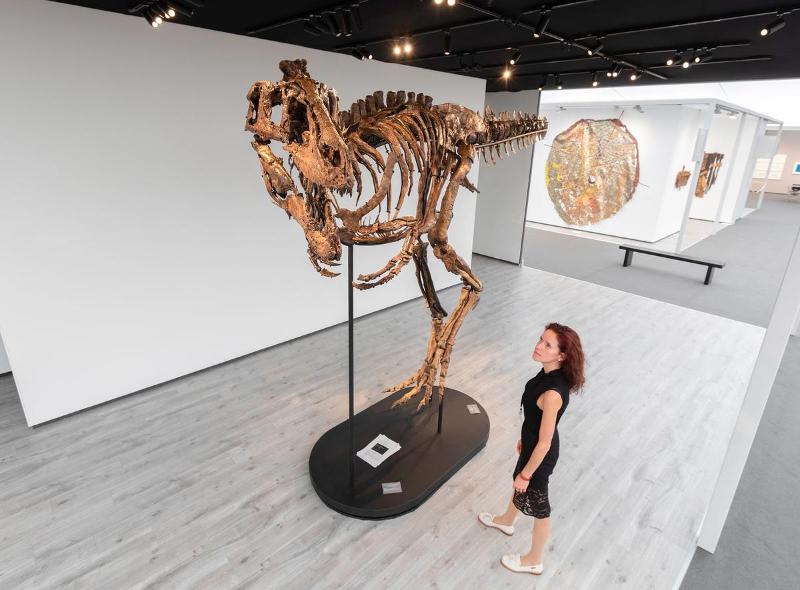Unearthed in Montana, US, Chomper is a once-in-a-lifetime discovery that is set to make waves at Frieze Masters. With a price tag of $20m, this juvenile T-Rex skeleton is the most expensive of its kind ever known to come to market. Join us as we delve into the remarkable story of Chomper, its rarity, and the growing fascination with fossils in the art world.
The Rarity of Chomper: A Once-in-a-Lifetime Discovery
Explore the exceptional rarity of Chomper, the juvenile T-Rex skeleton that has captured the attention of art enthusiasts and collectors worldwide.
Chomper's discovery is a truly remarkable event in the world of paleontology and art. With only a handful of juvenile T-Rex skeletons ever found, the chance to acquire such a well-preserved specimen is incredibly rare. The fact that Chomper is approximately 55% complete and its skull is over 90% complete adds to its uniqueness and desirability.
As an apex predator, most T-Rexes lived until adulthood, making the discovery of a juvenile specimen like Chomper exceedingly rare. Its exceptional completeness and preservation make it a once-in-a-lifetime find that has captivated the imagination of both art collectors and dinosaur enthusiasts.
Chomper's Unique Features: A Window into the Past
Delve into the distinctive characteristics of Chomper, from its strong bone color to its high number of original teeth, and understand why it stands out among other T-Rex skeletons.
One of the standout features of Chomper is its strong bone color, which is often faded in less well-preserved skeletons. This gives it a striking visual appeal and makes it a truly remarkable specimen to behold.
In addition, Chomper boasts a high number of original teeth, which is a testament to its youth and provides valuable insights into the growth and development of T-Rexes. These unique features make Chomper a highly sought-after piece in the art market.
The Growing Interest in Fossils: Art Collectors Turned Paleontology Enthusiasts
Discover the expanding fascination with fossils among art collectors and the increasing demand for historically important and aesthetically pleasing specimens.
While fossils have long been admired for their scientific significance, there is a growing interest in the art world for these ancient treasures. Art galleries, like David Aaron gallery, are now applying the same due diligence and standards used in the art market to fossils, providing buyers with a greater sense of security and understanding of the value of these specimens.
Private buyers, particularly those from the sciences and tech space, are increasingly drawn to fossils as investments and objects of aesthetic beauty. Additionally, regions that are building museums, such as the Natural History Museum Abu Dhabi, are acquiring significant fossils like Chomper, further fueling the demand for these extraordinary pieces.
The Impact of Fossil Auctions: From Sue to Stan
Explore the significance of fossil auctions in recent years, from the record-breaking sale of Sue to the unexpected success of Stan in the contemporary art market.
Fossil auctions have played a pivotal role in bringing these ancient wonders to the forefront of the art market. The sale of Sue, the Tyrannosaurus rex, at Sotheby's in 1997 for $8.3m marked a turning point, sparking widespread interest in dinosaur fossils as valuable collectibles.
More recently, the sale of Stan the T-Rex at Christie's in 2020 during an evening sale typically reserved for contemporary art shocked the art world. The record-breaking price of $30.8m demonstrated the immense value and appeal of well-preserved and scientifically significant fossils.
The Fascinating World of Fossils: Bridging Art and Science
Uncover the intersection of art and science in the world of fossils, as galleries like David Aaron gallery present historically important and aesthetically pleasing specimens to a diverse range of collectors.
Fossils, with their inherent beauty and scientific significance, have often been overlooked in the art world. However, galleries like David Aaron gallery are changing that perception by curating fossils that are not only historically important but also visually captivating.
By applying the same due diligence and expertise honed in the art market to fossils, these galleries provide collectors with a deeper understanding of the value and significance of these ancient treasures. This intersection of art and science is attracting a diverse range of collectors, from art enthusiasts to those with a background in the sciences and technology.
The Timeless Appeal of Dinosaurs: A Universal Fascination
Explore the universal appeal of dinosaurs and how they captivate people of all ages and cultures, making fossils like Chomper a source of wonder and awe.
Dinosaurs have a timeless appeal that transcends cultural and generational boundaries. When we encounter a triceratops or a T-Rex like Chomper, the impact is truly incredible, evoking a sense of wonder and curiosity in people of all ages.
Whether it's through popular culture references like the cartoon character Chomper from 'The Land Before Time' or the awe-inspiring scale and power of these ancient creatures, dinosaurs continue to capture our imagination. The universal fascination with dinosaurs makes fossils like Chomper a cherished piece of natural history and art.
Conclusion
Chomper, the most expensive juvenile T-Rex skeleton to hit the art market, is a testament to the rarity and fascination of fossils. Its exceptional completeness and unique features have captured the attention of art collectors and dinosaur enthusiasts alike. The growing interest in fossils, the impact of fossil auctions, and the intersection of art and science in the world of fossils all contribute to the timeless appeal of these ancient treasures. Chomper stands as a remarkable example of the universal fascination with dinosaurs and the awe-inspiring wonders of the natural world.

